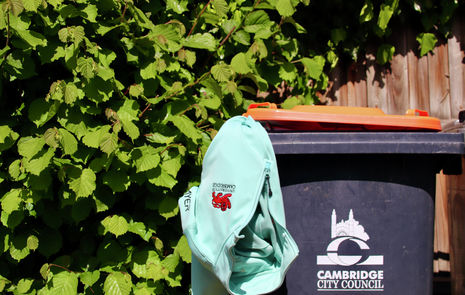Is stash just trash?
Lily Kemp discusses the links between Cambridge stash and global fashion waste

Many moons ago, when I was a wee Cambridge applicant, I would marvel at my sister’s university stash: her college puffer, her blues garms, and, most crucially, her Varsity sports sweatshirt. When I finally ordered my own college jumper, it came with a warning from my mum, a stash sceptic, to only buy clothes I would use in the long term. Her rationale: my sister’s stash legacy now dwells in a bin bag in the attic.
Stash is an essential part of university life. For sports, it makes you identifiable within your team, and it’s something practical to train and do matches in. I’m sure theatre kids are also thankful that it’s their show stash which is sacrificed to workshop wear and tear, instead of their everyday clothes receiving splatters of paint. Indeed, there’s nothing wrong with a cheeky college t-shirt donned as pyjamas. But at times, it can become over-indulgent: there seems to be an expectation to buy stash at every opportunity.
“There seems to be an expectation to buy stash at every opportunity”
Stories of Cambridge Blues spring to mind: when blues go for a group stash fitting, it can be a pressure cooker for blowing the budget. One player says it’s almost an expectation to buy some stash, never all of it, but at least something to show you’re part of the team. Varsity kits can vary in prices: some get their kit virtually free, as it’s sponsored, while other sports fork out between £25-£40 for tops and bottoms—and that’s only for one set. The highest end of the budget is the Blue’s Blazer, which is available for £245 from Ryder and Amies, around the same as a much sought after May Ball Ticket, (another costly Cambridge tradition). The price is high, and most likely inaccessible for the majority of students at Cambridge.
The other end of the stash spectrum is the more affordable t-shirt. This comes with its own slippery slope of overspending. There’s a danger of buying a T-shirt for every show or society you’re a part of; some hardcore theatre kids can end up with as many as 10-15 new ones every year, and to what avail, if a show only lasts a few weeks? But it’s either that, or feeling like you’re not part of the team.
“Stash contributes on a micro level to the global fashion waste problem”
Stash seems to be Cambridge’s contribution to the international fast fashion problem. Last year, £12.5 billion worth of clothes were thrown into landfill, weighing 300,000 tonnes; Boohoo’s sales increased by 45% in the first two months of the 2020 lockdown. These sales have been growing annually, despite public knowledge of poor pay for workers and clothing pollution. Although vintage fashion seems to be extremely popular in Cambridge, stash contributes on a micro level to the global fashion waste problem. It is very much bought today and bin tomorrow.
But there are some solutions. Ask yourself before buying: at either end of the price spectrum, will you still want to wear it in a couple of years’ time when you graduate? Will you use it frequently? Will you wear it outside of term time? Indeed, how viable is stash outside of Cambridge? It makes sense that in Cambridge, puffers have become part of the Hogwarts-esque aesthetic, but that doesn’t mean that they translate well outside of the city bubble. I wore my college puffer once on the Tube over the Christmas Vac. Once was enough. I felt like a fool.
So how can we make stash sustainable, when it functions best in Cambridge? You may not be like me; stash may be your breakfast, lunch and dinner, the staple food of your wardrobe. If that’s the case, I commend your ability to pull it off everywhere, for life. But for those of us drowning in unused stash, third year Delilah Knight has a solution: she turns her show t-shirts into part of a quilt. When she graduates not only will she have a sustainable and useful household item, but also, quite literally, a blanket full of memories. Still, there’s a simpler solution to stash excess: moderation.
In truth, I have no real qualms with stash, just with clothes being produced and not used. As buyers we must be conscious of the environmental impacts and economic implications of our clothes. However, like most things in life—drink, work, men—stash is good in moderation. And will I be buying a Varsity jumper this Easter Term? Most definitely.
 News / SU stops offering student discounts8 January 2026
News / SU stops offering student discounts8 January 2026 News / Uni-linked firms rank among Cambridgeshire’s largest7 January 2026
News / Uni-linked firms rank among Cambridgeshire’s largest7 January 2026 Comment / Plastic pubs: the problem with Cambridge alehouses 5 January 2026
Comment / Plastic pubs: the problem with Cambridge alehouses 5 January 2026 News / New movement ‘Cambridge is Chopped’ launched to fight against hate crime7 January 2026
News / New movement ‘Cambridge is Chopped’ launched to fight against hate crime7 January 2026 Comment / What happened to men at Cambridge?31 December 2025
Comment / What happened to men at Cambridge?31 December 2025









